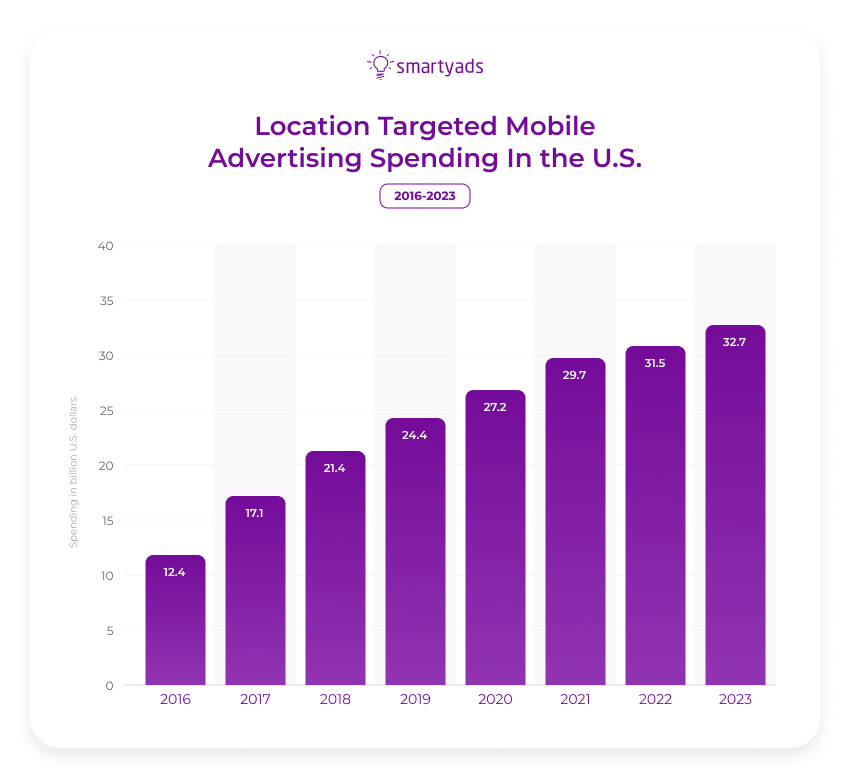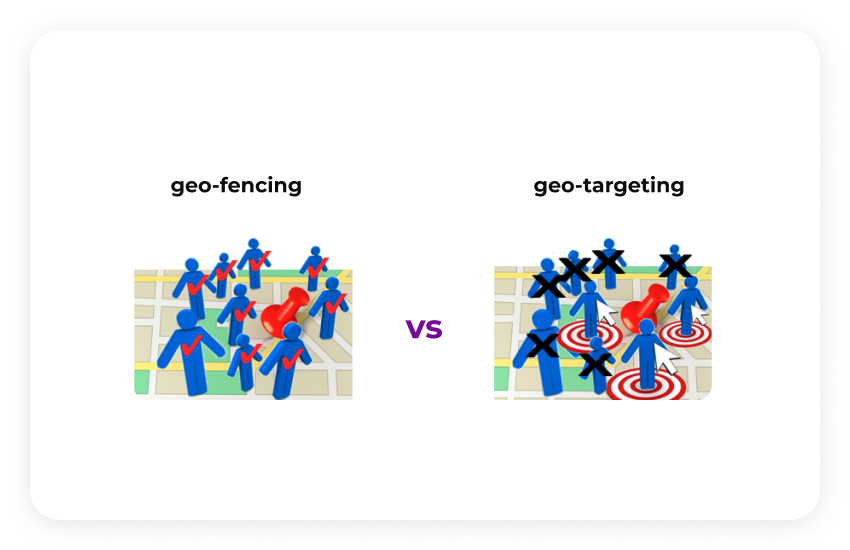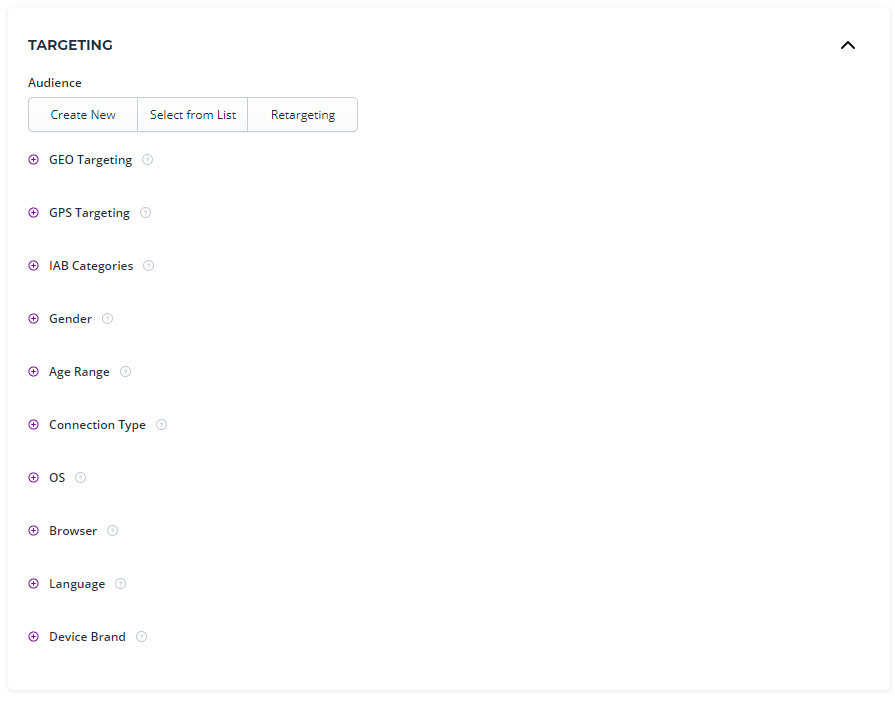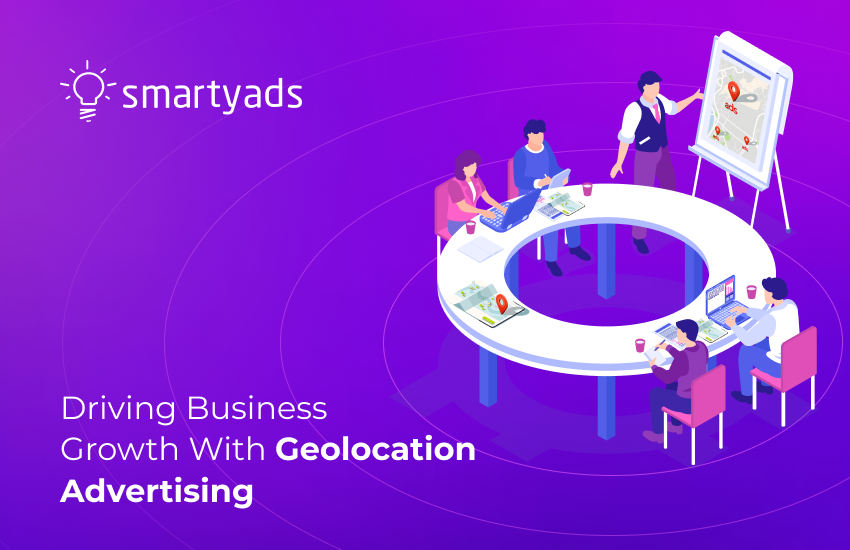You have encountered geolocation advertising without even realizing it. By harnessing this technology, businesses can deliver relevant and contextualized ads in real time, maximizing their effectiveness and capturing the attention of their target audience.
Every year, advertisers across all industries boost ad spending on location targeting. According to a study, location-targeted mobile advertising spending in the United States accounted for 31.5 billion U.S. dollars in 2022.

What is geolocation advertising?
Geolocation refers to the geographical location of an Internet-connected device — a laptop, a smartphone, or even a fitness tracker. This location data is used by geolocation advertising to serve marketing campaigns in particular areas.
Why do businesses utilize geolocation advertising?
In the current digital landscape, mobile gadgets have surpassed television regarding customer engagement, with smartphones leading the way as the dominant device.
During the last couple of years, the average time spent on mobile devices increased from 2.5% year-over-year (YoY) to over 4.5 hours per day.
Recognizing the shifting customer behavior, advertisers have found that addressing people based on their geographical location is more effective than addressing them solely on PCs and indoors. It encourages more store visits to brick-and-mortar stores and boosts conversions.
Businesses utilize geolocation advertising to leverage location data and target users in specific locations. Using geolocation technology, businesses can tailor their advertisements to reach consumers based on their location.
This allows them to optimize their ad spend by focusing on areas where their target consumers are present, increasing the chances of engagement and conversions. By delivering ads based on location, businesses can provide more relevant and personalized content to their target audience, leading to higher levels of engagement and improved marketing outcomes.
How do geolocation ads work?
There are three types of geolocation targeting:
Geo-targeting
How does geo-targeting work?
Geo-targeting works by utilizing IP addresses and geolocation data stored by Internet service providers (ISPs) to determine the geographic location of a user. When a user accesses the Internet, their device's IP address is captured. This IP address contains information that can be used to approximate the user's location. Geo-targeting technology analyzes this information and matches it to a specific geographic location.
IP addresses are linked to databases containing information about the region, city, or even coordinates associated with the IP address. By comparing the IP address to this database, businesses can identify the user's location with reasonable accuracy. This allows businesses to deliver targeted content or advertisements based on the user's location, tailoring their marketing efforts to specific geographic areas.
Overall, geo-targeting enables businesses to enhance their advertising strategies by reaching users in specific locations and delivering more relevant and personalized content based on the user's location data.
Geofencing
Geofencing creates a virtual boundary around a specific location, allowing marketers to target customer devices within that set boundary with ads, offers, etc.
Using geofencing, advertisers use a smartphone's GPS location instead of IP addresses, enabling them to identify customer locations and track their movement.
Moreover, some geolocation software can collect geolocation data in real time by connecting to GPS and cellular networks.
Below is a visual comparison between geo-targeting and geo-fencing.

So, when to choose geo-targeting and when geo-fencing?
Geo-targeting is beneficial when targeting a broader audience within a specific area and delivering location-specific messaging. It provides flexibility in terms of audience reach and can be effective for various marketing objectives.
Geofencing offers a higher level of precision as it targets users based on their real-time proximity to a particular location. It is ideal when you want to engage with users who are physically present at specific places, such as retail stores, events, or competitor locations.
Beacons
The most particular form of geolocation marketing relies on beacons — small devices located in certain geographic locations.
Beacons have been created to get data from devices' Bluetooth signals.
This technology identifies where prospective clients walk within a space, enabling targeted marketing.
Beacons are perfect for poor reception spaces, like department stores.
However, they have a limited communication range and can be difficult to set up and manage on public property.
![]()
For instance, advertisers can utilize beacons to determine when customers are in the ice cream selling area and then send them a discount coupon for ice cream cones.
Target ads to geographic locations
Let's review geo-targeting ads as the most popular form of geolocation advertising.
For geo-targeting ads to be effective, you must target the right place with the relevant content at the right time. The simplest method to avoid wasting clicks is to utilize a precise location.
For instance, if your business is based in Maui, Hawaii, and you can't deliver to any other U.S. region, then you should only promote your products and services to Maui residents.
Another example: if you target people in a tourist destination, it makes sense to serve ads to people based on their places of interest — local restaurants, near the beaches, or in hotels.
Programmatic advertising platforms are most accurate and cost-effective when you want to launch geo-fencing or geomarketing ad campaigns.
The geo-targeting feature is available on nearly every programmatic media-buying platform.
Furthermore, with a wide range of targeting options, the platform can assist in personalizing messages when a brand intends to reach multiple audience segments.
Where can you launch geolocation advertising campaigns?
Geolocation targeting in online ad campaigns is most straightforward and impactful when integrated with mobile marketing, particularly if most location data is derived from mobile devices.
Social networks offer different ways for geolocation targeting; for this, you can use Facebook ads.
Advertisers can easily create audiences on these platforms based on specific locations, including where people live, work, and places they frequently visit: nearby cities, towns, designated market areas (DMAs), and states.
Additionally, you can target based on location groups, which include business locations, demographic segments, and places of interest.
Popular social platforms like Facebook, Instagram, and Twitter enable advertisers to upload their data to generate custom audiences.
These platforms connect their audiences with advertisers who look for location-based users.
Google Ads location targeting allows advertisers to define specific geographic locations for their ads to reach customers on Google search and partner websites.
Also, don't miss the opportunity to utilize a programmatic advertising platform. It uses real-time bidding and advanced algorithms to target customers based on their real-time location across various websites and apps, offering broader reach and flexibility in ad placements.
Benefits of Geolocation Advertising
Geolocation offers several benefits for businesses:
Increased Relevance
By leveraging geolocation data, businesses can deliver personalized and contextually relevant content to users based on their location. This level of customization enhances the user experience and increases the effectiveness of advertising campaigns.
Improved Ad Efficiency
Geolocation advertising allows businesses to optimize their ad spend by focusing on areas where their target consumers are physically located. Instead of wasting resources on a broad audience, businesses can allocate their budget to specific regions or locations, maximizing the return on investment.
Local Marketing Advantage
For businesses with physical locations, geolocation advertising is especially valuable. It helps drive foot traffic to their stores by targeting users in the vicinity and delivering enticing offers or promotions. This boosts local marketing efforts and increases the likelihood of conversions.
Competitive Edge
Geolocation advertising can provide a competitive edge by allowing businesses to target users near competitor locations. By offering exclusive deals or incentives, businesses can attract customers away from competitors and increase market share.
Examples of Brands Utilizing Geolocation Ads
Burger King
To take advantage of Burger King's offer, customers needed to be in close proximity (within 600 feet) of any of the 14,000 McDonald's restaurants and place their Whopper order through the Burger King app.
After placing their 1-cent order, the app directed them to the nearest Burger King for pick-up.

This tricky scheme utilized app-based geofencing to change prices when users entered the geofence around McDonald's.
Uber
Every brand can include relevant, urgent information in your location-based notification, like Uber, so the user has all the information necessary to make an informed decision.

Adidas
Adidas implemented location extensions in their search ads to promote in-store visits, encouraging visitors to purchase at the nearest store.
As a result, one in every five individuals who viewed the page followed through by visiting a physical store.
This impressive statistic contributed to a remarkable 680% increase in ROI for Adidas.
Whole Foods
Whole Foods employed geofencing and geomarketing strategies to boost conversions and gain market share.
Special discounts were offered to customers of nearby supermarkets to encourage them to shop at Whole Foods.
This campaign's conversion rate was 4.69%, compared to the national average of 1.43%.
How to run a geolocation advertising campaign?
Below you can find some practical tips regarding starting a geolocation ad campaign on SmartyAds DSP:
Begin with the basic settings, like choosing the traffic type, device, and active time for your campaign on DSP. Then add targeting, including location and other targeting options.
We recommend selecting a few so you don't narrow your potential traffic too much.

Regarding geo-targeting, choose those cities and those countries where you want to address your audiences in specific areas. In this case, the users in other locations won't see your ads.
If you choose GPS targeting, you can define the areas right on the map. We recommend using it if you need to set areas smaller than the country, bigger than the city, or smaller than the city (if you want to target the city district).
You can focus the map on some country, city, or zip code. Just type them in and select a suitable location.
To create a targeting area, select its type (Include or Exclude), and click on a point on the map. 10 km circle will appear on the map, and a record of that circle will appear above the map. Included areas will be in the green circle, and Excluded areas in the red circle — navigate those to make your choice.
Additionally, you can utilize DSP guidelines if you have any questions.
Moreover, you can find the best practices for targeted advertising on a blog and stay up to date.
To sum it up
Geolocation marketing is an extremely valuable tool in the advertising industry.
Not only does it aid in delivering personalized messages to prospective consumers, but it also enables your business to compete and develop effective geolocation advertising campaigns.
For businesses looking to boost their ad campaigns, investment in geolocation technology can lead to success.
Deliver your messages to the right place at the right time with SmartyAds DSP.




